#chordate
Text

he is staring respectfully
#prionance glauca#blue shark#meme#shitpost#fish#eukarya#animalia#chordate#chondrichthyes#elasmobranch#selachimorph#carcharhiniformes#carcharhinidae#p. glauca
2K notes
·
View notes
Note
why did you tag that horse video with #chordate? the organizational system that implies fascinates me

3K notes
·
View notes
Text

Dinovember day 3! Pikaia! One of the first animals to have a spine, which means yes, you might be looking at a distant relative >:3
We all came from slug
#art#digital art#sombertide art#paleoart#paleontology#natural history#paleo#cambrian#slug#pikaia#palaeoblr#palaeontology#palaeoart#sea life#ancient life#dinovember#chordate#chordata#what a funky little guy#this one took me the least time so far#getting better at this style
313 notes
·
View notes
Text
The modern world is nice, but sometimes you just get the urge to go primitive. Because I'm a complete wimp who would die within a day of giving up the internet, I'm going to deal with that urge by talking about primitive animals. It's Wet Beast Wednesday and I'm talking about lancelets.

(image: a lancelet. Not much to look at, are they?)
Lancelets, or amphioxi, are highly basal (close to the ancestral form) chordates that are vaguely similar to fish, but are vastly more primitive. They have all the characteristics of chordates, the key one being a notochord, a flexible rodlike structure that goes down the body. The majority of chordates that are still alive are vertebrates, who have incorporated the notochord into the spinal column. The other groups of surviving chordates are the tunicates (who I'll get to eventually) and the lancelets. Because lancelets are so primitive, they are used at model organisms representing an early stage of vertebrate evolution. It was originally thought that lancelets are remnants of an early lineage that eventually evolved into vertebrates. Genetic studies later showed that tunicates are actually more closely related to modern vertebrates than lancelets. They are still used as a model organism as they are a fantastic representation of early chordates. The similarity of lancelets to the 530 million year old Pikaia gracilens, one of the earliest known chordates, is one of the reasons they are such a useful model organism.

(image: a diagram of lancelet anatomy by Wikipedia user Systematicist)
Lancelets can be found all over the world, living in temperate to tropical shallow seas. The only known exception is Asymmetron inferum, which has been found around whale falls at 225 m (738 ft) deep. They are small animals, reaching around 8 cm at their largest. An amphioxus looks pretty worm-like, with a simple mouth at one end and a pointed tail at the other. The name amphioxus means "both (ends) pointed" which is a pretty appropriate description. The mouth is lined with tentacle-like threads called oral cilli, which are used for feeding. Lancelets are filter-feeders that use the cirri to filter plankton, microbes, and organic detritus. Water and food pass into the pharynx (back of the mouth), which is line with gill slits. This is where it gets weird. The gill slits aren't used for respiration, but for feeding. Mucus gets pushed through the gill slits by cilia, trapping the food and moving it deeper into the digestive tract. Not only to lancelets not use their gill slits to respirate, they actually don't have a respiratory system at all. Instead, they just absorb dissolved oxygen through their thin and simple layer of skin. Their circulatory system doesn't move oxygen around either as there is no heart or hemoglobin present. For what it's worth, they don't have a proper live either. When you look at a lancelet's anatomy, you can see similarities to fish anatomy, just much more primitive and with some parts missing.
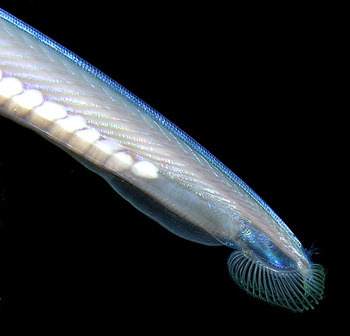
(image: the head of a lancelet, with mouth and cilli visible)
Lancelets have 4 different systems used for vision. Two, the Joseph cells and Hesse organs, are simple photoreceptors that are on the notochord and detect light along the back of the animal. Imagine having a bunch of very simple yes on your spinal cord that can see through your skin. There is also a simple photoreceptor called the lamellar body (which confusingly is also the name of a type of lipid) and a single simple eye on the head. Speaking of light, lancelets are florescent, producing green light when exposed to blue to ultraviolet light. In all species, the proteins responsible for this are found around the cilii and eye, but some species also have them in the gonads and tail. The purpose for this florescence isn't exactly known, but a common hypothesis is that it helps attract plankton toward their mouths.
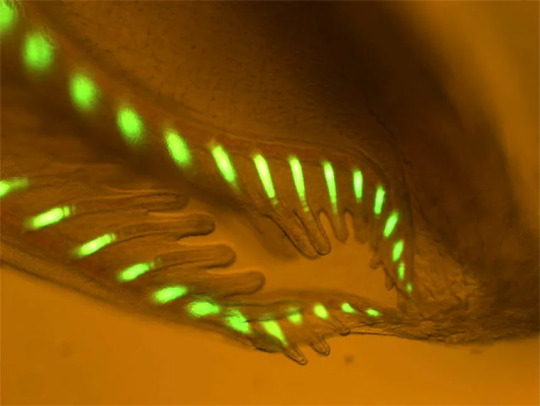
(image: an extreme close-up of a lancelet's cilli fluorescing)
Lancelets have seasonal reproduction cycles that occur in summer. Females release their eggs first, followed my males releasing sperm to fertilize them. Depending on species, spawning can either occur at specific times, or gradually throughout breeding season. Development occurs in several stages. In the frist stage, they live in the substrate, but they will quickly move into the water column to become swimmers. These swimming larvae practice diel vertical migration, traveling to the surface at night and returning to the seafloor in the day. While larvae can swim, they are still subject to the current and can be carried long distances. Adults retain their ability to swim, which is done by wriggling like an eel and in some cases, spinning around in a spiral fashion while moving forward. Unlike the larvae, adults spend most of their time buried in the substrate with only their heads exposed. They typically only emerge when mating or if disturbed.
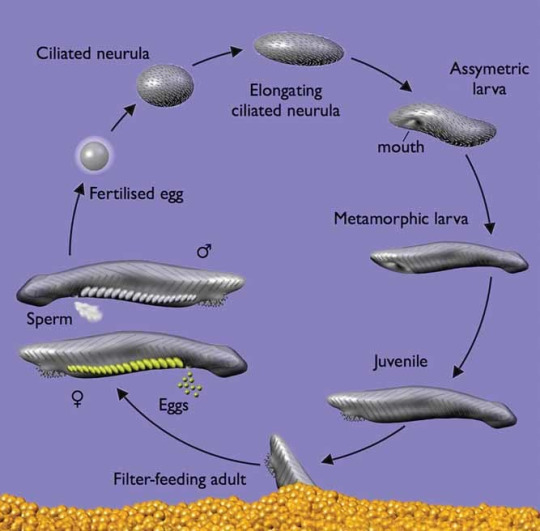
(image: a diagram of the lancelet life cycle. source)
Because of their use as model organisms, humans have developed methods to keep and breed lancelets in captivity. The majority of research has been done on Branchiostoma lanceolatum, but several other species have been studied. Multiple species are endangered due to pollution and global warming. Several species are edible and can either be eaten whole or used as a food additive. In spring, when their gonads begin to develop for breeding season, they develop a bad flavor.
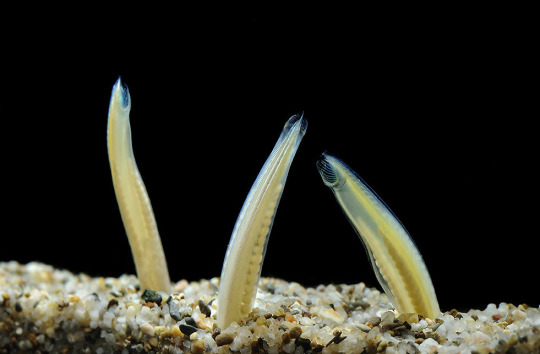
Mom: "we have garden eels at home". Garden eels at home:
(image: three lancelets sticking their heads out of the sediment)
#wet beast wednesday#weird-ass tube beast#lancelet#amphioxus#chordate#chordata#marine biology#biology#ecology#zoology#animal facts#evolutionary biology
234 notes
·
View notes
Text
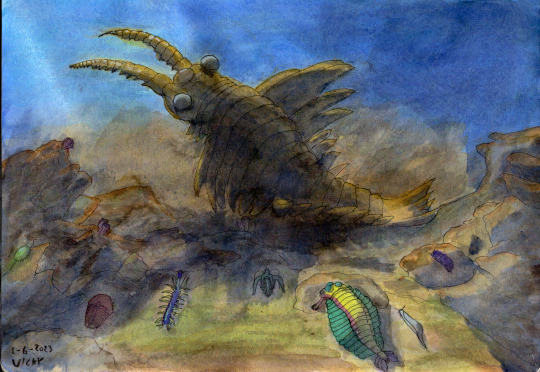
Mighty Anomalocaris stirs, spreading dust and terror throughout the Cambrian sea. Opabinia, Hallucigenia, Pikaia, Canadia, Burgessia, Marella, and Elrathia can only hope the rocks and ridges they cover behind will hide them.
#cambrian#anomalocaris#Opabinia#Hallucigenia#Pikaia#Canadia#Burgessia#Marella#Elrathia#hazelia#radiodont#arthropod#paleoart#my art#palaeoblr#lobopod#trilobite#chordate#sponge#cambrian explosion
175 notes
·
View notes
Text
Most popular animal tournament
#tumblr polls#poll#random poll#i love polls#poll time#my polls#polls#daily polls#poll for funsies#Animals#tumblr poll#hyperspecific poll#poll for everyone#poll for you#poll fun#poll tournament#poll game#polladay#polls polls polls#polls are fun#random polls#silly poll#tournament poll#poll blog#tournament polls#animal#chordate#chordates#fish#frogs
12 notes
·
View notes
Text

Kollikodon Presents: Hot Cross Bunodon WIP
GAHHHH!! So close to Easter! I juuuuust missed it! Maybe I can make it presentable tomorrow? maybe...
#my art#paleoart#hot cross buns#WIP#easter#Kollikodon#stem monotreme#mammal#animal#chordata#chordate#paleoblr#bread rolls#hotcrossbunodon#bunodon#teeth#mesozoic#mesozoic mammals#bread#australian prehistory#lightning ridge#did she lay those eggs in the background? Whooooo knoooows???#prehistoric mammals#palaeontology#paleontology#digital art#eggs#easter egg
9 notes
·
View notes
Text

a fossil a day keeps the sad vibes away
jawless fish friday?? can i get a shoutout to all the jawless fish? this guy is from the maotianshan shale beds and might be one of the first chordates, making them an ancestor to all vertebrates including you and me!
#fish#ichthyology#chordate#paleoart#paleontology#dinovember#dinovember2022#art#artists on tumblr#illustration#illustrators on tumblr#gif#procreate#mine#paleozoic pals#fossil art#digital art#palaeoblr
112 notes
·
View notes
Text

Rock doves (Columba livia), along with an American crow (Corvus brachyrhynchos), a European starling (Sturnus vulgaris), and way in the back, a house sparrow (Passer domesticus); March 2023
Washington DC
City bird extravaganza!
#2023#march#chordate#avian#columbiformes#columbidae#columba livia#passeriformes#corvidae#corvus brachyrhynchos#sturnidae#sturnus vulgaris#passeridae#passer domesticus
10 notes
·
View notes
Text

Pikaia, an early chordate.
5 notes
·
View notes
Photo


Starry Flounder (Platichthys stellatus) and C-O Sole (Pleuroichthys coenosus)!
#eukarya#animalia#chordate#actinopterygii#pleuronectidae#pleuronichthys coenosus#platichthyes stellatus#starry flounder#c-o sole#flatfish
6 notes
·
View notes
Note
thank you so much!!!!!!! I just looked up "what the sneef I'm snorfin here animal" and your tags from a year ago informed me that it was an elephant shrew!!! those are such delightful creatures!!!! you are responsible for bringing so much joy into my life!!!!!!! Thank you thank you thank you!!!!! I love their silly little snouts!!!!
See, it's moments like this that are the real reason why I tag everything!
And yeah elephant shrews rule.
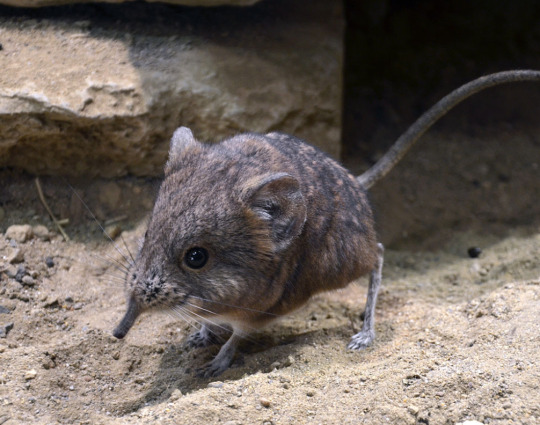
Look at this little freak. It owns.
Elephant shrews (aka sengis) are related to aardvarks, manatees, and of course, elephants. (They aren't especially closely related to true shrews though.)
They belong to the taxonomic clade Afrotheria, which are basically a bunch of mammals that evolved in Africa in the Cretaceous period when it wasn't connected to Eurasia, so they diversified and spread out into lots of different environmental niches.
Presumably a lot of these Afrotherians died out as a result of competition with animals in the same niches from Eurasia when the continents came together, but thankfully we are still left with megafaunal elephants, big ol' sea cows, tiny insectivorous elephant shrews, semi-aquatic giant elephant shrews (potamogalidae), golden moles, and probably my personal favorite: tenrecs which are funny little hedgehoggy mouse-lookin' things that are basically only found in Madagascar.
Like, look at this picture of a lowland streaked tenrec.

It looks like an electric type Pokemon dude.
images yoinked from wikipedia (because I was too lazy to find more interesting or obscure pictures lmao):
1 round-eared elephant shrew
2 lowland streaked tenrec
#ask#Anonymous#elephant shrew#jmc#tags#tagging#animal#chordate#mammal#afrotherian#tenrec#lowland streaked tenrec#sengi#what the sneef? I'm snorfin' here!
4 notes
·
View notes
Text
god i love taxonomy. especially the broader groups like phyla because it results in:
this

and this
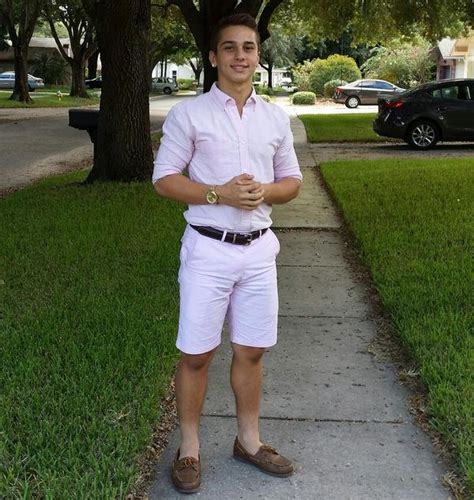
being in the same group
386 notes
·
View notes
Text
Phylum Round 1

Chordata: All animals with a backbone (Vertebrata), but also some invertebrates. Chordata includes fish, birds, mammals, reptiles, and amphibians, but also sea squirts and lancelets. All Chordates have a notochord (supportive rod-like structure), a hollow dorsal nerve cord, pharyngeal slits (for filter feeding/breathing), a post-anal tail, and an endostyle (feeding organ) or thyroid (hormonal gland). Interestingly, many Chordates have overcome the need to raise their young in water by laying shelled eggs or carrying young within the womb. Fur, feathers, and scales are all unique adaptations found within Chordata. This phylum exhibits remarkable diversity overall.
Entoprocta (Kamptozoa): Goblet Worms or Nodding Animals. These small cup-shaped animals filter feed using the ciliated tentacles surrounding the "rim". Their most distinctive feature is their "nodding" behavior on their long thin stalk. They can live in marine, brackish, or rarely freshwater habitats. While they closely resemble Bryozoans, they differ in that their anus is located inside the ring of tentacles, rather than outside. Some Entoprocts can live on top of other organisms, taking advantage of the mobility and food-bearing water currents.
#hydrogen bomb vs coughing baby#did I add my own cat as a chordate? Yes. is she a perfect example of a mammal? Also Yes if you don't count the fact that she's missing a leg#chordata#entoprocta#animal bracket#tumblr bracket#bracket tournament#poll bracket#phylum round 1#phylum
115 notes
·
View notes
Text

Controversial opinion but this is the same question. Every vertebrate is a fish
54 notes
·
View notes
Text




Fat Echidna found on Woppa (they do inhabit the island as well as the mainland).
Sadly, while driving to Yeppoon, we saw a lot of dead echidnas on the road... The highway is frequently covered in native animal roadkill. At least on Woppa, there's little chance of an echidna being runover.
BTW, despite looking like hedgehogs, they're very much unrelated. Echidnas are their own thing (closely related to the platypus).
11/09/23 - Mammalia: Tachyglossus aculeatus - Woppa, cabin area
#Tachyglossus aculeatus#Echidna#Monotremata#Monotremes#Mammalia#Mammals#Prototheria#Prototherians#Vertebrata#Vertebrates#Chordata#Chordates
115 notes
·
View notes